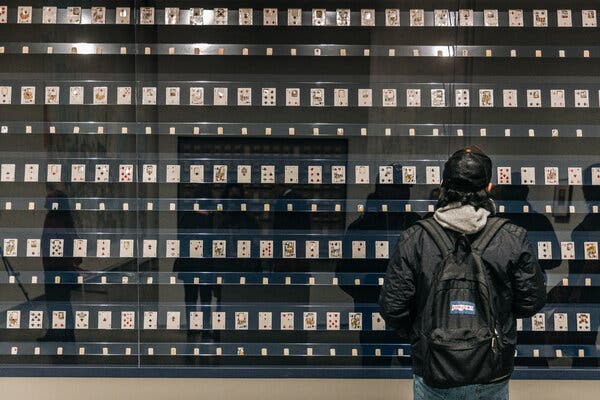Jesse Krimes makes art that stems from his six years in prison on drug charges. But he isn’t trying to evoke what it feels like to be jailed. Rather than portray the dehumanization of individuals in the system — as, for example, Gordon Parks did in his 1957 Life magazine photos at the San Quentin prison — Krimes marshals the strategies of conceptual and pop art. He appropriates and manipulates images he takes from the media or art history books, everything from mug shots to medieval tapestries, to recreate the fragmentary way that the world filters through to the incarcerated. The works, which are often large-scaled, aim to convey the enormity of the American penal system, which confines nearly two million people in federal and state prisons.
His art is the subject of two New York shows, at the Metropolitan Museum of Art and the Jack Shainman Gallery. In “Jesse Krimes: Corrections” at the Met, the curator Lisa Sutcliffe cannily pairs his work with a panoply of Alphonse Bertillon’s mug shots of suspected anarchists, which the Paris police assembled as part of a machinery of surveillance in the 1890s. The wall of grim standardized portraits faces off against “Purgatory” (2009), a piece that Krimes, 42, made during a year of pretrial solitary confinement.

Repurposing decks of poker cards, which the prison inmates played by calling out hands from their isolated cells, Krimes glued together 21 cards with toothpaste to make a flat brick, cut out a rectangle from a face card he placed on top, and then filled the cavity with a small bar of prison-issued soap on which he had transferred a mug shot drawn from a local paper’s crime reports. Eventually, he branched out to include portraits of celebrities, in the belief that anyone might become an outlaw. He constructed nearly 300 of these and mailed them out, two at a time, to a friend. “Purgatory” is now in the permanent collection of the Met.
Before falling afoul of the law, Krimes had earned a degree in art from Millersville University in Pennsylvania in 2008. Once he was convicted and sent to a federal penitentiary, he embarked on a project even more ambitious than “Purgatory”: “Apokaluptein: 16389067” (2010-13). (The title is a combination of the Greek word for “apocalypse” and the identification number he was issued in prison.)
This post was originally published on this site be sure to check out more of their content.






